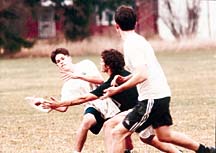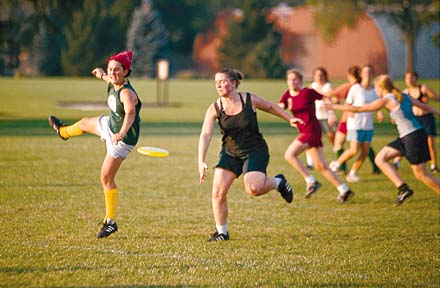 Ultimate player recruitment at
Oberlin has always combined the
haphazard with the fortuitous. The game is now widespread enough that some players come with high school experience; Takahashi, for one, first picked it up while a freshman at New York City's select Stuyvesant High School. The sport has also been peculiarly successful at attracting athletic late-bloomers. But some of the best Ultimate players have always migrated over from more established sports, especially the aerobically and spiritually simpatico soccer. College athletes like James King '78, now a doctor but then an early soccer-to-Ultimate convert, exemplified the cross-over. Such players come initially for off-season conditioning, or for a lark, or because they're hungry for something fresh.
Ultimate player recruitment at
Oberlin has always combined the
haphazard with the fortuitous. The game is now widespread enough that some players come with high school experience; Takahashi, for one, first picked it up while a freshman at New York City's select Stuyvesant High School. The sport has also been peculiarly successful at attracting athletic late-bloomers. But some of the best Ultimate players have always migrated over from more established sports, especially the aerobically and spiritually simpatico soccer. College athletes like James King '78, now a doctor but then an early soccer-to-Ultimate convert, exemplified the cross-over. Such players come initially for off-season conditioning, or for a lark, or because they're hungry for something fresh.
Karen Schlanger '91, who in 1989 helped found the Praying Manti, Oberlin's first women's team, recalled how she and her teammates "stole some players from other sports, including soccer, field hockey, and basketball." Natalie Celeste '93, an experienced soccer sweeper, said she was drawn in by the chance to play an endurance sport-"I liked that challenge"-and stayed as she discovered how "cool, fit, and focused" her Ultimate teammates were.
 "Playing a varsity sport, there was a
certain professionalism expected by the coach," said Celeste, who now works for
a Cleveland non-profit group. "With Ultimate, we were all the collective coaches. Even if the captains were tyrants,
practices were hard but fun."
"Playing a varsity sport, there was a
certain professionalism expected by the coach," said Celeste, who now works for
a Cleveland non-profit group. "With Ultimate, we were all the collective coaches. Even if the captains were tyrants,
practices were hard but fun."
Fittingly for the nation's first coed college, the Oberlin men's and women's Ultimate teams have long had a tight, if not incestuous, relationship. Coed play had begun in Oberlin's Intramural leagues by 1977. Talented team players like geology major John McAlpin '78-now a teacher-joined with enthusiastic amateurs like dancer Sara Hostetler '77-now a movement therapist and performer-on the archetypal 1977 intramural championship team called Just For Fun. From such casual play, Oberlin's traveling club team through the 1980s fluctuated back and forth between men's only and coed. Creative tension inevitably arose, as the Just For Fun attitude ran up against the imperatives of tournament competition. Oberlin, famously home to some of the nation's first coed dormitories, had to figure out when and where men and women athletes should play together.
"It got really ugly for a while," recalled Annie Zeidman, a history major and one-time PhD student who now works for a California non-profit. "So in typical Oberlin fashion, we had a meeting for everyone to air their opinions. It was a neat meeting, held on the second floor of Wilder...I think we worked out some weird, Oberlinesque compromise of playing one and a half games of coed each week, or something nutty like that."

With its weekend road trips, exhausting practices, and games that are both endlessly entertaining and intellectually engaging, Ultimate inevitably draws its core of players into a tight fraternity. "When I think about about Oberlin 20 years ago, I think about hanging out with the Ultimate team-it was the funnest thing I did and nothing compares with it," said James Miller. A generation later, Keck found that "Ultimate was the single most significant experience of mine at Oberlin. I spent an extraordinary amount of time on it." Naturally, such an all-consuming activity inspires an evolving glossary of in-jokes, buzz words, and disc hipster lingo that binds players together and keeps outsiders scratching their heads. Oberlin players, at varying times, have "gone horizontal" or "laid it out" by diving for the disc. They've been urged to "go ho," and been cheered for heartfelt efforts with shouts of "good bid." Maya Kabat '93, now in graduate art school, noted that a women's player who'd caught the Ultimate obsession was said to have "got the love."
Oberlin is about searching and, for the fortunate, it's about finding. Some people find what they're looking for in the Kettering labs, the Con's practice rooms, or the Co-ops' kitchens. Others find it on the playing fields, where they run as hard as they can and then launch themselves into air, extending beyond their old limits until they've got it. Until they've got the love.
<< part 2
Michael Doyle is a reporter in the Washington bureau of McClatchy Newspapers. He played on the Oberlin Ultimate team from 1976 to 1978.
- Back to Oberlin Ultimate part 1
- On to The New Guggenheim: Where We are All Happy Geniuses
- Back to the OAM Spring 1999 Table of Contents